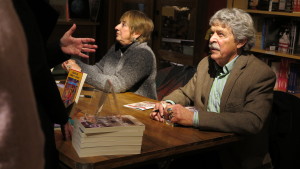Tags
Related Posts
Share This
Past / Present

Hart’s book ‘Sephardic Jews: History, Religion, and People’ details the Sephardim’s history from medieval Spain to their immigration to the Americas.
The month of November has been difficult for many in America, including myself. Bigotry is on the rise, and every day seems to bring disheartening news. Nonetheless, on Nov. 29, upwards of 50 people squeezed themselves into Collected Works Bookstore, braving the frigid weather outside to hear Dr. Ron D. Hart in conversation with Gloria Abella Ballen. The topic of discussion was Hart’s latest book, Sephardic Jews: History, Religion, and People, which brings together the narratives of Sephardic Jews who were exiled from Spain and settled throughout the world. Perhaps most significant to this audience was that so many Sephardic Jews settled along the Rio Grande river when they arrived in the Americas, including northern New Mexico. Hart, a cultural anthropologist who has studied the history of medieval Spain’s Jews, is currently a research associate for the Center for Latin America and Iberian Institute at the University of New Mexico. Abella Ballen wrote and illustrated The Power of the Hebrew Alphabet; she has exhibited her art all over the world as well as taught at multiple universities.
As the clock inched toward 6 p.m., the seats filled, some of us spilling over onto tall stools, others settling into sofas. All around, friends greeted each other with cries of “hi, sweetie!”, hugs, and kisses. We shed our jackets like second skins to guard our seats while we retrieved coffees and teas, reveling in the warmth within the store. More than most, this reading was about community and safe spaces, visible in the way people threw around weather complaints to neighbors and made small talk.
Dr. Hart and Abella Ballen took their places at the stage, perched on folding chairs at a little table. Cecile Lipworth, event coordinator for Collected Works Bookstore, secured the audience’s attention with a mike tap before introducing the night’s guests of honor. Hart’s latest book focuses on Jews as the other, seen in medieval Spain where they were persecuted by Christian kingdoms to the north, a persecution which followed them to the Americas in the Inquisition. Here, Lipworth paused to acknowledge the shadow hanging over the room. “We face a lot of othering in America at this time,” she admitted, and the audience murmured in agreement.
Abella Ballen’s questions to Hart were designed to deepen the audience’s understanding of the history of Sephardic Jews, though the conversation remained casual and sometimes playful. After Abella Ballen asked how Spain become such an important magnet for Jews, Hart smiled and responded, “You know we’ve talked about this before, right?” In many ways, this discussion mirrored their conversations over dinner at home, something both acknowledged throughout the night. To answer her question, he explained the religious tolerance of Umayyad Muslim rulers, which attracted many Christians and Jews to Spain. He also emphasized that our idea of convivencia in Spain is undoubtedly a rose-colored view of the situation; the uneasy coexistence of Muslim, Jewish, and Christian cultures was a marriage of convenience, one that was eventually obliterated with the Reconquista. In 1492, the Christian monarchs Ferdinand and Isabella defeated the last Muslim kingdom in Granada, making Spain a Christian nation. Under the Alhambra Decree, Jews who had not converted to Christianity were expelled from Spain, given only four months to pack up their entire lives and leave behind all currency, properties and businesses. To return to Spain after leaving would have been an automatic death sentence.

Gloria Abella Ballen and Dr. Ron D. Hart sign books and converse with attendees after the event.
Throughout the night, the audience laughed at Hart and Abella Ballen’s jokes and gasped whenever Hart brought up a lesser-known facet of history, such as the estimates of the number of Jews murdered during the Inquisition. Everyone was there to learn and connect with each other, to be within the community ensconced in a local bookshop one cold November night. At the end, one audience member explained that though he was from Spain, he had only recently discovered his Sephardic Jew heritage. His desire to understand his past was mirrored by the audience. To come together at a time when life is so disheartening for people was powerful and affirming. To have a space carved out, safe and warm with coffee and friends, a refuge from both the weather and daily life — it meant something. Attendees queued up to purchase signed books and converse with Abella Ballen and Hart, many lingering to speak with friends before leaving. As for myself, I entered Collected Works that night and didn’t know a single soul but, after, lingered to speak.






 Jackalope Magazine is the student magazine of Santa Fe University of Art and Design. Building on the interdisciplinary nature of our education, we aim to showcase the talent of our university and character of our city.
Jackalope Magazine is the student magazine of Santa Fe University of Art and Design. Building on the interdisciplinary nature of our education, we aim to showcase the talent of our university and character of our city.
0 Comments
Trackbacks/Pingbacks